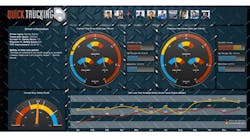Improving supply chain operations starts with visibility. Without seeing what’s happening in the network, planning is based on old norms and supply chain managers are forced to react manually to changes and disruptions. And manual adjustments are usually less than optimal.
Supply chain visibility systems give forecasting systems current, relevant information on which to more accurately forecast what demand will be at the point of consumption, whether that is near term or sometime in the future.
Visibility alone has only marginal value, however. That is why the early standalone visibility systems never got much traction. Visibility solutions integrated with planning and execution systems can help managers more accurately position inventory to match expected sales, and enable immediate reaction when disruptions occur. This closed-loop visibility—planning—execution process creates supply chains that are more cost effective, provide better customer service, and are more profitable.
Two-Sided Visibility
Supply chain visibility is traditionally thought of in terms of visibility to inventory and supply disruptions. While this is important, it is also reactionary. It doesn’t allow supply chain operations to learn from history. That comes from demand-side visibility. Visibility to demand—what is selling in stores and other channels on a day-by-day basis—provides a feedback mechanism to forecasting and demand planning that enables these systems to better understand what is happening on the street. This allows these systems to create and adjust plans to more accurately match inventory, labor and transportation to forecasted demand at the point of consumption.
Thus, there are two sides to supply chain visibility—the demand side, which more accurately matches inventory to demand, and the supply side, which provides real-time information to alert execution operations to supply chain changes and disruptions. The trick is to get the two sides working together to create a continuous learning loop where planning not only learns from visibility to actual demand, but also from visibility to the changes that occur during execution.
Iterative Planning and Execution
The continuous learning loop is embodied in a process called iterative planning and execution. Traditional planning processes are linear—from forecast to plan to execution. They don’t do a good job of understanding and responding to the constant, rapid-fire changes in customer demand emblematic of today’s marketplace. More recently, analytics have been added in an attempt to provide some feedback into the planning process. But this process is often too slow to adequately react to daily demand shifts, and usually is not connected to execution systems to enact needed changes.
Iterative planning and execution is different. Instead of a linear process, it is a continuously self-adjusting loop. This process receives visibility to daily item-level sales in order to forecast future demand, create inventory plans accordingly, and pass the plans to execution. The loop continues with execution systems receiving real-time visibility to supply chain changes and disruptions so immediate adjustments can be made. These execution changes are passed back into the planning process so they can be considered in future planning. The iterative nature of this process allows plans to continuously improve the accuracy of the planning process in order to narrow the gap between forecast and actual demand. The smaller the gap, the more efficient supply chain operations will be, leading to better service and profitability.
Separating Wheat from Chaff
One important consideration when using supply chain visibility to inform iterative planning and execution loops is the need to separate the relevant, impactful information from the red herrings that are not relevant or have little to no impact on actual demand. Otherwise the data can lead to inappropriate decisions that whipsaw plans away from actual demand. For example, a spike in demand caused by a promotion is very relevant, while an apparent spike in demand that was caused by an accident in which a truckload of product was destroyed may not be as relevant for forecasting even though inventory plans must be adjusted to replace the lost inventory. That is where the iterative planning and execution process kicks in.
Thus, iterative planning and execution processes must be able to filter causal information from the outliers and background noise that constant supply chain visibility makes available. This filtered information provides what we call actionable visibility.
Actionable visibility allows the iterative planning and execution loop to profitably react to shifts in demand, new priority orders, customer order changes, supply chain disruptions and other changing conditions to adjust fulfillment strategies and capabilities, re-plan transportation or modify DC capacity accordingly. None of this can be done adequately, much less optimally, with manual processes and spreadsheets. It requires intelligent, integrated supply chain technology.
Command and Control
Just as in the physical world, there is a lot going on in an iterative planning and execution process with real-time visibility to supply and demand. What is needed is a command and control hub to monitor and direct this action. That hub acts as a traffic cop, using upstream and downstream information to direct execution across the entire distribution network to most economically and profitably fill orders while meeting service commitments. It decides from where to fulfill orders whether that is from a factory warehouse, a DC, a store or a drop-ship site anywhere in the network. These decisions must be based on time-phased visibility to inventory and allocations at all locations, factoring in labor availability and transportation costs. The command and control hub should also factor in considerations such as inventory balancing, product lifecycles and product rotation rules.
Because this iterative process is driven by real-time visibility, profitable promising decisions are not made just once. Instead, visibility to changes initiates a re-promising process so that execution will still be as profitable as possible given the new conditions. The iterative process continues as new changes come in and existing orders are executed to meet service commitments. This produces the most efficient and profitable solutions while improving customer service.
Visibility Improves Planning and Execution
Today’s markets are in constant motion. Change is non-stop. No matter how good your planning is, no matter how efficient your execution is, without visibility to what is happening upstream and downstream in your supply chain, you are flying blind. With visibility, you can make better decisions that more accurately position inventory to match demand.
Fab Brasca is vice president strategy, JDA Software (www.jda.com).





